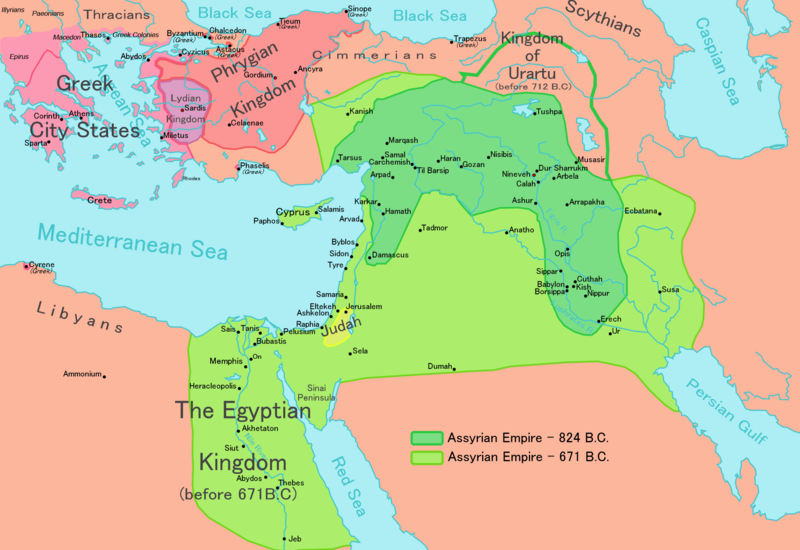Facts for Kids
The Neo-Assyrian Empire was a powerful kingdom that thrived from about 911 to 612 BC, known for its strong military, beautiful art, and advanced knowledge.
Overview
Notable Rulers
Economy And Trade
Decline And Legacy
Art And Architecture
Cultural Achievements
Religion And Mythology
Relations With Neighbors
Geography And Capital Cities
Military Organization And Warfare
Political Structure And Administration

Inside this Article
The Epic Of Gilgamesh
Ashurbanipal
Tigris River
Bureaucracy
Literature
Assyrian
Building
Culture
People
Trade
Good
Did you know?
🗓️ The Neo-Assyrian Empire lasted from about 911 to 612 BC.
🌍 It covered parts of modern-day Iraq, Turkey, and Syria.
🏙️ Nineveh was the capital city of the Neo-Assyrian Empire.
👑 Powerful kings like Ashurbanipal led the empire.
⚔️ The Assyrian military was one of the most feared armies in history.
🛒 Trade was essential, with goods like textiles and metals being exchanged.
🙏 The Assyrians worshiped many gods, with Ashur being the chief god.
🎨 They were known for their beautiful art and impressive architecture.
📚 The Neo-Assyrian Empire had one of the world's first libraries in Nineveh.
⚠️ The empire began to decline around 600 BC due to internal struggles and invasions.
Introduction
️ This empire was famous for its great kings and big cities! The Assyrians lived in what we now call Iraq, Turkey, and parts of Syria. Their capital city was Nineveh, which was a bustling place full of grand palaces, libraries, and amazing gardens. 🌳
The Assyrians were known for their advanced skills in war and building, making them one of the most important civilizations of ancient times!
Notable Rulers
King Ashurbanipal was famous for his vast library and military prowess. He ruled from 668 to 627 BC and expanded the empire significantly. Tiglath-Pileser III, who ruled earlier, was known for his military campaigns that transformed the empire. Another great leader was Sennacherib, who built the magnificent city of Nineveh! Each of these rulers left a mark on history through their leadership and achievements.
Economy And Trade
They traded many goods, such as textiles, metals, and grains. The Assyrians used a system of roads to transport items quickly across their land. 🌾
They took advantage of their rich resources and traded with other cultures like the Egyptians and Babylonians. The economy also relied on farming, with farmers growing crops like barley and wheat. This trading helped the empire grow wealthy and strong!
Decline And Legacy
️ Internal struggles, along with attacks from enemies like the Medes and Babylonians, weakened the empire. In 612 BC, Nineveh was captured, and the empire fell apart. Despite this, the legacy of the Neo-Assyrian Empire continues! 📜
They introduced innovations in writing and warfare that influenced later cultures. Art, literature, and religious beliefs from this empire still shape our understanding of ancient civilizations today!
Art And Architecture
They created beautiful sculptures, detailed wall carvings, and colorful pottery. The famous Assyrian lions and winged bulls guarded the entrances of their palaces. 🦁
Their architecture featured impressive ziggurats and large stone buildings. The walls of palaces were covered in murals showing their kings and gods. The art they created was not only beautiful but also told stories of their culture and achievements!
Cultural Achievements
They created one of the world's first libraries in Nineveh. This library contained thousands of clay tablets with stories, poems, and information about farming and medicine. The Epic of Gilgamesh, one of the oldest stories in the world, was found among them! The Assyrians also advanced in astronomy and mathematics, helping us understand the stars and numbers better. Their culture influenced many future civilizations!
Religion And Mythology
Their chief god was Ashur, the god of war and the city's protector. They built temples to honor their gods and believed that their success depended on pleasing them. The Assyrians told many stories about their gods, including tales of creation and mighty battles. 🌌
Festivals were celebrated with music, dancing, and food. Religion played an essential role in everyday life, guiding the people's actions and choices.
Relations With Neighbors
They often fought against powerful kingdoms like Babylon and Elam. Sometimes the Assyrians formed alliances, but they also conquered many surrounding areas. 🔗
They spread their culture, language, and ideas through their conquests. Although many feared them, other kingdoms admired their leaders and achievements. This connection with neighbors shape the region's history and influence!
Geography And Capital Cities
Its heartland was in northern Mesopotamia, mainly around the Tigris River. The capital city, Nineveh, was located on the Tigris River near modern-day Mosul, Iraq. 🏙
️ The Empire controlled lands that included parts of what we now call Syria, Turkey, and even Iran! With mountains in the north and deserts in the south, the empire had many different landscapes!
Military Organization And Warfare
️ They had chariots, archers, and even soldiers who could fight with swords. The army was well-organized into divisions, allowing them to attack quickly and efficiently. 🏇
They fought many battles to expand their land, often using tactics like surprise attacks. The Assyrians were good at building fortifications and siege machines, which helped them conquer cities. Their strength made them powerful and dominant in ancient times!
Political Structure And Administration
Kings like Ashurbanipal and Tiglath-Pileser III were famous for their leadership! The empire was divided into provinces, each with a governor to help the king. These governors collected taxes, maintained order, and made sure everyone followed the laws. 📜
The capital had an impressive palace where the king lived and held meetings. The bureaucracy was complicated, but it helped the empire run smoothly!

